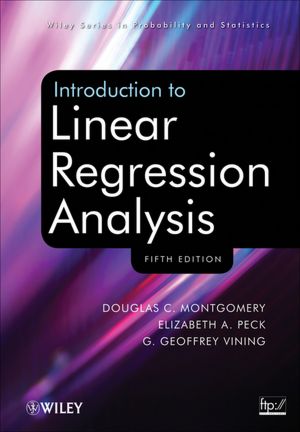Introduction to Linear Regression Analysis pdf download
Par dye laura le samedi, septembre 5 2015, 23:36 - Lien permanent
Introduction to Linear Regression Analysis. Douglas C. Montgomery, Elizabeth A. Peck, G. Geoffrey Vining
Introduction.to.Linear.Regression.Analysis.pdf
ISBN: 9780470542811 | 672 pages | 17 Mb

Introduction to Linear Regression Analysis Douglas C. Montgomery, Elizabeth A. Peck, G. Geoffrey Vining
Publisher: Wiley, John & Sons, Incorporated
The left panel shows the best-fit linear regression line This lines minimizes the sum-of-squares of the vertical distances of the points from the line. An introduction to multiple linear regression, extending the techniques used in simple linear regression to more than one independent variable. In essence, regression is not necessarily accurate for non-linear cases. Various authors report different values of the distance between Based on this model we introduced a measure of deviation of peptide masses from the nearest cluster centre, which is a refinement of a measure proposed by Wool and Smilansky [10]. This book is suitable for graduate students who are either majoring in statistics/biostatistics or using linear regression analysis substantially in their subject fields. Linear regression can be a fast and powerful tool to model complex phenomena. For each subject (or experimental unit), you know both X and Y and you want to find the best Microsoft Equation 3.0. The use of this package to obtain important summary features in different data structures. In part 1 of this series we introduced the topic of employing linear regression models to predict sales for a hypothetical company. Distributions of estimators and residuals. Those vertical distances are also shown on the left panel of the figure. Afterwards, the linear dependence between the decimal point and the integer part is determined by regression analysis, for a relatively small mass range of 500 to 1000Da [23]. The heteroscedasticity in classical linear regression model is defined by the variances of random items and which are not the same for different explanatory variables and observations [1], [2]. In part 2 we introduced the data and using RapidMiner generated a linear regression model. In this post, I will introduce some diagnostics that you can perform to ensure that your regression does not violate these basic assumptions. Linear regression analyzes the relationship between two variables, X and Y. Introduction to linear regression. An introduction to mutiple regression. A review of the simple linear regression. Wheelan provides a very interesting limitation for regression.
